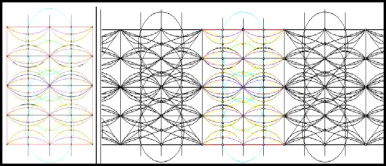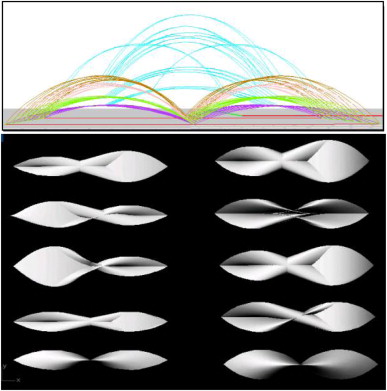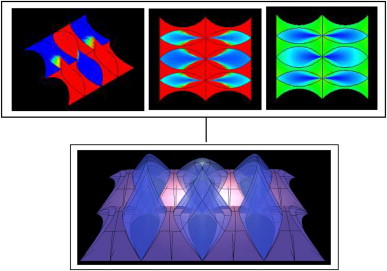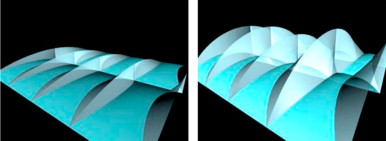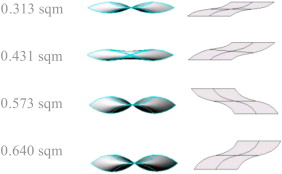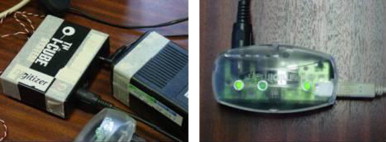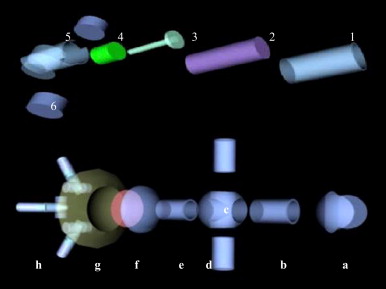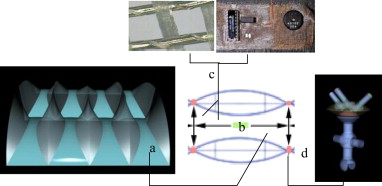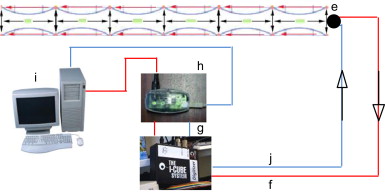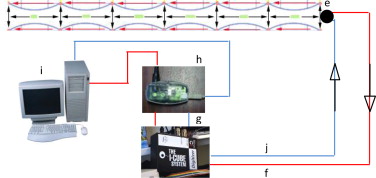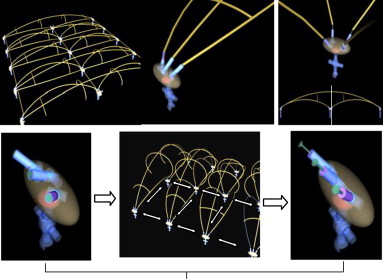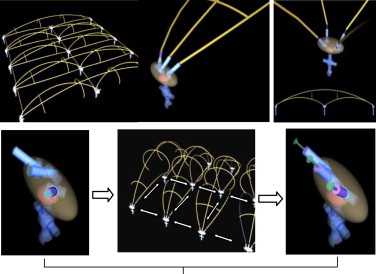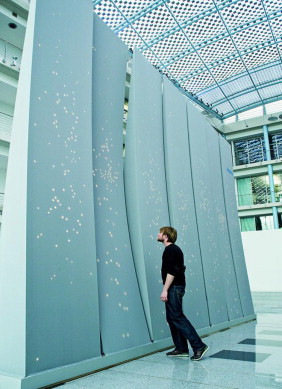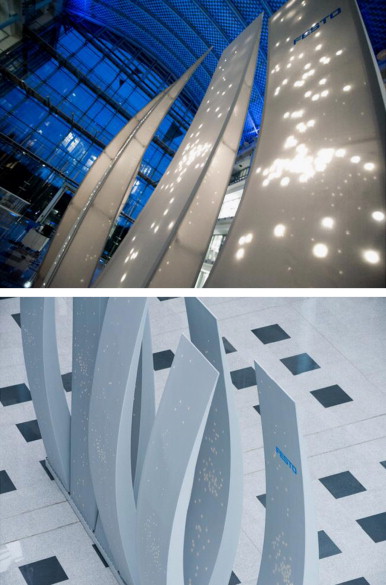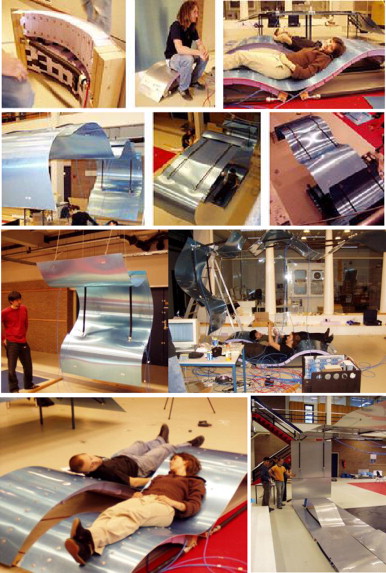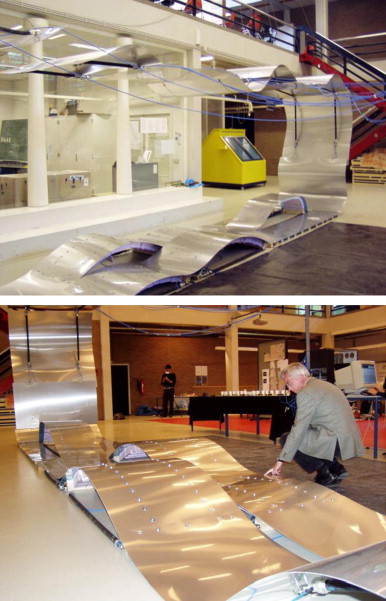Abstract
The design-research illustrated in this research article focus on the emerging field of interactive architecture focusing on developing real-time information exchanging architectural bodies. These interactive bodies demonstrate a fusion between the material, the electronic and the digital domains. This fusion is explicitly attained through a synergistic merger between the fields of ambient sensing, control systems, ubiquitous computing, architectural design, pneumatic systems and computation. The resultant spatial bodies are thus visualised as complex adaptive systems, continually engaged in activities of data-exchange resulting in physical and ambient adaptations of their constituting components in response to contextual variations. Interdependent nodal networks, where every node/junction of a spatial prototype becomes a potential information hub by means of its ability to collect, process and communicate contextual data apart from working as an actuated detail owing to its ability to kinetically re-position itself in three-dimensional space is thus a critical outcome of this inter-disciplinary way of working. A strategy apt for binding material logistics with the digital to materialize dynamic spatial behaviours owing to real time data exchange between the prototypes and their context is thus embarked upon via three research and design projects, namely: Electronic Media Augmented Spatial Skins, The InteractiveWall and the Muscle Re-configured.
Keywords
Real-time interaction ; Sensing and actuation ; Performance ; Adaptation ; Emergence
1. Introduction
The contemporary environment is increasingly being engulfed in a networked digital information exchange based paradigm. However, the interfaces that constitute this new paradigm are almost entirely confined to conventional graphical user interfaces comprising of keyboards, monitors and mouse. The potential of re-envisioning the physical environment itself as an interface to this very digital medium thus becomes an interesting proposition. It is in this context that the paper explores the importance associated with information regulation and the creation of the much-speculated real-time interactive forms of architecture, which thrive on a purposeful fusion of the digital and material domains.
Ishii and Ulmer (1997) , stress on the idea of giving physical form to digital information by coupling the dual worlds of bits and atoms. The age old conception of architectural space as a closed system is seen as a complete contrast through this paper to perceive architecture as a subject for real time adaptation.
The systemic prototypes, expanded upon in this paper are conceived via multidisciplinary studies in the field of emergence (Johnson, 2001 ; Hensel and Menges, 2006 ), natural systems, self-organisation and self-renewal. The paper exemplifies the dynamism inherent in biotic systems, and applies the study of such complex systems through a synergetic merger of the fields of electronics, material technologies, embedded computation, sensor and actuation systems and swarm behaviour based principles. The products hence are an active contribution to the much-researched field of information driven, real time responsive architecture. The paper exemplifies information exchange by means of tactile variations of physical entities, generated as a resultant of human, environmental and contextual intervention. Tangible adaptation is manifested via integrating physical materials with digital, electronic and information media. Carefully assigning the generated data into a display that successfully masks the information into new forms and gestures (by means of the nature of information generated, the tectonic variations etc.), in the visual, tactile or audio space (multi-modal) is thus speculated through the research investigations.
2. Theoretical framework
The following section exemplifies the underlying theoretical concepts explored during the projects. I will try and break down the argument into three sub-parts in order to communicate the proposed context: self-organisation, swarm architecture and adaptation.
2.1. Self-organisation
Self-organisation is referred to as a process in which the internal organisation of a system increases automatically without being guided by an external source. The self-organising theory has found its application in a variety of fields such as physics, chemistry, humanities, economics, social science and biology, however, the research ideologies set up for the architectural design research find their underpinnings in the biological perspective. Numerous substantiations in the biological world such as the process of growth, metabolism, and evolution collectively called morphogenesis (Broughton et al ., 1999 ; Biloria, ) have found their application in the architectural realm by inducing systems thinking into conceptualising architectural space. Data scapes and a variety of diagramming techniques are now following such biotic phenomena to deliver calculative mathematical output engrained with logistics and reasoning at their core. The principle of homoeostasis, which deals with maintaining the nature of the system at different evolutionary stages, has also found its parallel in information driven, ‘alive’ architectural context.
Such complex data processing bodies, which are engaged in continuous exchange of energy, harness homoeostasis for self-renewal in order to maintain a dynamic balance in the constant parametric operations that the system is subjected to. Self-organising societies such as ants, bees and many mammals are being constantly analysed for their behavioural instincts, in order to decipher a complex architectonic where stress is on the interaction of the actors constituting the complex system. Such behaviours have further implications on the act of swarming behaviour to generate complex actions such as flocking behaviour or a communal manner of systematising a specific action. With the increasing interdisciplinary notions that architectural process is attuning itself with, the criterion of making the outcome more intelligent and autonomous is thus an active area of research in the contemporary. Vital feedback is attained by studying the emergent behaviour produced by the patterns of interactions of individual parts (which are intelligent actors in themselves). The projects utilize this scientific construct to envision a responsive whole.
2.2. Swarm architecture
Swarm behaviour (Reynolds ) seen as a subsystem of self-organisation illustrates the behaviour of a group of agents that may be able to perform tasks without detailed representations of the environment and other agents. Such behaviour can often produce functionality even though the individual actors are not aware of it. In the architectural context, the creation of a self-organising automaton inherently involves visualising building components as individual real time data processing entities. This implies a continual variable data output with respect to the data scapes with which the elements are in constant communication (the environment). A cohesive and interdependent relation is hence accomplished in real time, with the capacity to process both external and internal forces with equal emphasis on both. This behavioural aspect can also be applied to visualise the whole societies of architectural bodies constantly exchanging data and updating themselves in real time, further producing complex adaptive behaviour. The projects will exhibit such behaviour at various levels: through tangible as well as virtual precepts.
2.3. Adaptation
Adaptation is a critical process in the field of evolutionary biology, which is specifically concerned with the origin of species from a common descent and decent of species, as well as their change, multiplication and diversity over time. Adaptation as a process can be defined as the change in living organisms that allow them to live successfully in an environment. It enables living organisms to cope with environmental stresses and pressures. According to Huxley (1975 ), adaptations can be categorised as structural, behavioural or physiological:
- Structural adaptations are special body parts of an organism that help it to survive in its natural habitat (e.g., skin colour, shape, body covering).
- Behavioural adaptations are special ways a particular organism behaves to survive in its natural habitat (e.g., phototropism).
- Physiological adaptations are systems present in an organism that allow it to perform certain biochemical reactions (e.g., making venom, secreting slime, and homoeostasis).
These three features, namely structural, behavioural and physiological adaptation, in the architectural domain formulated the crux for developing bottom-up performative spatial systems. A component based approach can thus be embarked upon where, akin to cells in natural systems, components can be seen as intelligent building entities endowed with abilities of structural, behavioural and physiological adaptations. In the case of building components, adhering to a performative agenda (per component) of the three aspects of adaptation is seen as follows:
- Structural adaptations is seen as a by-product of the inter-dependence between geometry, material and fabrication based affordances in order to produce structurally stable component variations (e.g., creating morphological variations of the same component in terms of shape, size, etc.)
- Behavioural adaptations is closely associated with the domain of responsive interaction which the component should inherit in order to successfully survive and communicate with its context in both active and pro-active ways (e.g., kinetic abilities, information exchange abilities, ambient abilities, sensorial abilities.)
- Physiological adaptations in the case of building components is directly linked with the manner in which the component can deal with issues of self sustainment (e.g., energy conservation, retention and dispensation abilities, power generation, distribution and circulation abilities.)
3. Design research projects
The following design research projects are exemplified in this section: Electronic Media Augmented Spatial Skins, the Emotive InteractiveWall and the Muscle Re-configured. The three projects are specifically selected in order to showcase multi-scalar implications of fusing the aforementioned theoretical frameworks. Scalar variations such as the component scale (skin), an architectural element scale (wall) as well as an interior scale are thus featured in this article. Design driven thinking and the creative, yet, systematic inclusion of computational and technological domains to address the issue of real-time adaptation and interaction of architectural space are thus explained in this paper. Besides the scalar variations, the parameters to which these experiments respond also vary. Environmental variations (sunlight, wind, sun angle), movement of people, proximity of people, speed of approaching an installation as well as the coordinates of constituting components of architectural space are some of the vital parameters that the three experiments selectively address. Modalities, as regard to physical adaptation, sonic adaptations as well as lighting based adaptations stemming from a systemic integrated approach towards architectural design are also be exemplified via the three experiments.
3.1. Electronic media augmented spatial skin
3.1.1. Overview (emergent thinking)
The skin is conceived as an external cladding based modular panel system that can actively sense dynamic changes of the atmosphere, for instance the sun angle and the amount of light based variation, and act in correspondence to these parameters to actuate real time reconfigurations in the structural/spatial make-up of the panels locally. The simulated modulations thus, depend entirely upon variable parametric input registered by each panel locally, creating a nonuniform but highly performative alteration required to be made at an individual level while affecting the whole in an emergent fashion. Each individual panel is also intrinsically connected to its immediate neighbours, generating a swarm-like infrastructure, which, while working interdependently, morph an orthogonal façade into an organic and highly efficient filter of environmental data. This tactile response based adaptation is also inspired by cellular structure based adaptations, namely, the manner in which shape changes at the micro cell structure affect shape changes at a macro level.
3.1.2. Materialisation
The basic dimension of the panel is derived from a typical modernist office block and analysing its external façade for opening heights, sill levels, lintel levels etc. The sunlight, and sun angle, shadow patterns and thermal gain data are also considered in relation with the location and the orientation of the built form. The project aims at simulating a scenario where the cladding system can be deployed directly on the existing façade, or could form the external skin independent of the existing façade constraints and hence provide a breathable environmental control envelope for the interior. A material module of 2 m×2 m, striated into strips of 0.5 m×2 m is hence arrived at (Fig. 1 ). Two-dimensional network of curves attained from the striation process are further utilized in the generation of three dimensional component topologies. A number of alternatives are experimented with, by lofting the network of boundary curves attained from Fig. 1 , with different geometric lofting based affordances: Normal, Loose, Tight, Developable, and Straight segments to arrive at two geometric topologies which could constitute the panel (Fig. 2 ).
|
|
|
Fig. 1. The 2D striated diagram illustrating the network of curves corresponding with the anticipated opening patterns of the skin. The curve network is generated as a result of an emergent continual striation process of the 2D geometry resulting in strips of 0.5 m×2 m. |
|
|
|
Fig. 2. Genotypes developed from the same curvature network: The samples are generated by lofting the same network of boundary curves, but considering different limits: Normal, Loose, Tight, Developable, Straight segments. The bottom-most row of alternatives outlining the minimum and maximum expansion of the curve netwroks were eventually chosen for further curvature analysis. |
The final topology selection is derived after a thorough analysis of the narrowed down topologies generated from the aforementioned curvature based lofting process. The selected set of curve network based lofts served as the upper and the lower limits of expansion, which the same surface could inherit. This assured that the dimensions of the expansions would always stay within the specified striation limits. The derived topology conditions were further subjected to a three-dimensional curvature analysis in order to visualise the stress and strain conditions that the surfaces would inherit under wind exposure based loading conditions (Fig. 3 ). This process not only aided in the determining a fit candidate, whose topological conditions presented the least structural weakness but also helped in tracing the underlying network of curves which will further aid in developing the kinetic mechanism responsible for the minimum and maximum adaptation of each panel locally.
|
|
|
Fig. 3. Curvature analysis of the selected topologies leading to the selection of a fit candidate for further processing. |
3.1.3. System components (swarm based network of component constituents)
The system is perceived as a network of components working in coherence with each other to generate the desired tectonic variations. This section elaborates upon the system components, exemplifying dimensional variations, material allocation and performance criteria of each component individually.
3.1.3.1. The membrane and the strata
The surface is subdivided into two distinct entities: the membrane and the strata. The strata being the protruded surface condition and the membrane being the flexible surface layer to which the strata is connected (Fig. 4 ).
- Material allocation: Flexible perforated latex/resin, transparent in nature.
- Performance criterion: Allowing the skin to be breathable (for hot air circulation and ventilation), Expansion and contraction in the Pores will in turn result in a heightened or vice versa level of transparency.
|
|
|
Fig. 4. Surface typologies and the derived from the initial curve networks. The surface assemblage: the membrane, the strata at two extreme stages. Left: minimum expansion; Right: maximum expansion. |
The membrane based area variation, derived from the initial curve network displays the following volumetric expansion sequences (Fig. 5 ).
|
|
|
Fig. 5. Membrane component based area variation and their unrolled surface conditions. |
The strata based area variation at different stages of expansion (Fig. 6 ):
- Material allocation: Specially woven elastic latex double skin, with embedded elastic conductive threads, translucent in nature, embedded sunlight sensing devices, sandwich panelling of active polymer gels, interconnected via elastic conductive threads.
- Performance criterion: Flexibility, and durability with an ability to retain the original shape, ability to sense sunlight data from the surrounding environment and transmit the data through conductive threads, elastic nature of the conductive threads aids the shrinking and expansion of the modulating fabric.
|
|
|
Fig. 6. Strata component based area variation. |
3.1.3.2. The connectors
The connector elements are derived from the aforementioned network of three-dimensional curves, which constitute the genetic makeup of the surface typologies. The connector element is categorised into two typologies, owing to its direct connectivity with the two surface variants: the membrane and the strata: the arch shaping the strata, the arch shaping the membrane (Fig. 7 ).
- Material allocation: Connected network of carbon fibre tubes with hinged joints at critical junctions allowing for movement, according to the stretch induced by the surface membrane
- Connected to the strata as well as the membrane.
- Performance criterion: Be able to adjust its shape according to the movement of the membrane fabric; be able to simulate change in the strata by being able to drag and stretch it along the X and the Z coordinates.
|
|
|
Fig. 7. (a) Arch shaping the strata; (b) Arch shaping the membrane. |
Both categories witness different cumulative angular variations during the different stages of surface actuation (Fig. 8 ). These changes in the arch network are calculated by means of comparing the dimensional variations (both angular and linear) at different stages of expansion and contraction that the whole systemic network witnesses:
- Cumulative change in length in each individual arch: 162.05 mm
- Increase in the opening size (horizontal): 127.51 mm.
- Cumulative change in the angle of the arch shaping the strata: 16.75°
- Cumulative change in the vertical dimension of the strata: 162.58 mm
- Cumulative change in the angle of the arch shaping the membrane: 28.65°
- Cumulative change in the vertical dimension of the membrane: 398.93 mm
|
|
|
Fig. 8. Connecting framework exhibiting the initial and the final stages of expansion that is witnessed during the actuation process. |
3.1.3.3. Analogue to digital converters
The I-cube digitiser (Fig. 9 ), is used to convert the analogue signals received by the sensors into digital data and to convert the digital signals given out as a response of these received values from the central processing unit into an electrical field to activate the polymer gel actuators.
|
|
|
Fig. 9. The I-cube digitizer and the distributor of inputs from the digitizer serves as an appropriate medium for transferring the sensed data to the central processor and to transmit information to the systemic hardware by converting analogue signals to digital and vice versa. |
3.1.3.4. Central processor
A central data processing unit calculates and sends out impulses based on various inputs from the sensors implanted in the membrane skin. The unit will be in turn connected to the data format-converting device that is mentioned above. A systemic layout is worked out in accordance with the rows and columns based arrangement that the responsive panels will be subjected to and the manner in which the data is sent/received will also be charted out accordingly.
3.1.3.5. Electro active polymer gel actuators (distributed processing)
Actuator components (Fig. 10 )
- 1> External stainless steel casing tube 5 cm in radius with the voltage cable connection
- 2> Internal casing housing the active polymer gel layers 4.8 cm in radius
- 3> Piston connected to the active polymer gel layers 8 to 10 cm in length
- 4> Layers of active polymer gels, with an expansion capacity of four times their original thickness
- 5> Bottom piece with housing for attachment of rotary motor
- 6> Motors attached for rotating the mechanism to accommodate the required deformation.
|
|
|
Fig. 10. The active part of the (actuators) positioning element consists of a stack of polymer gel discs separated by thin metallic electrodes. The maximum operating voltage is proportional to the thickness of the discs. The stack actuators are manufactured with layers from 0.02 to 1 mm in thickness. |
Connector components (Fig. 10 ):
- a> Stainless steel connector (attached to building facades: I beams or mullions)
- Connector rod
- b> Junction element, catering to wiring, distribution, and data transfer cables
- c> Connecting hollow tubes
- d> Cap element with connector hollow tube, as an outlet for data cables
- e> Microchip and motor mechanism
- f> Housing element for the actuators
- g> Actuators.
3.1.3.6. Sensing devices
Woven into the weave of the strata (Fig. 11 ), the sensors are proposed to be thin solar cells (about 1.5 mm thick). These work based on the principle of silicon releasing electrons in response to photons in the suns rays. If one layer of silicon is treated to make it rich in electrons, and the other treated to make it contain far fewer, then a flow or electric current can be produced between the two. Alternatively, some devices like the PVC-1 from remote measurement systems (a 1 cm by 1 cm square photovoltaic cell) could be utilised directly in order to activate the polymer gel actuators since they have the capacity to produce a high degree of voltage. Amorphous thin film prototype module manufactured by Solarex in the 1990s was also found to be an efficient film that could be used for the solar sensing purposes.
|
|
|
Fig. 11. The strata illustrating the embedded solar sensor. |
3.1.4. System architecture
The creation of a self-organising automaton, inherently involved visualising system components as individual data processing entities, capable of processing data in real time while being actively linked with other elements of the system. This implies a continual variable data output with respect to the data scapes with which the elements are in constant communication (the environment). The skin is visualised as an integral whole with all the components as members of the swarm, working constantly to generate activity patterns. A cohesive and interdependent relation is hence accomplished in real time, with the capacity to process both external and internal forces with equal emphasis on both. The networked behaviour of the system components is elaborated upon in a sequential manner in the following sections:
- Phase 1: Sequential flow representation (Fig. 12 )
- Strata (a), and with the embedded sensing device (b).
- The sensing device registers the amount of sun and light intensity falling on an individual panel and transfers the information via the embedded control system (c).
- The silk organza weaving (connecting the sensor in the strata) with embedded computation to the actuating nodes (d)
- As discussed earlier, each actuator (d) possesses distributed processing within each node with an embedded micro controller.
|
|
|
Fig. 12. Information sensing and routing sequence (phase 1). |
- Phase 2: Sequential flow of data (Fig. 13 ).
- The actuators, through the shortest route transmits the data to a central node (e).
- The signals received at (e), are still in analogue form (f).
- This data is transmitted to the I-cube digitizer (g)
- The digitizer receives the analogue signals and processes it further via the midi converter (h) into a digital format
- (h) Feeds this digitised information into the CPU (i)
- In the CPU, MAX MSP, the data processing software generates actuation information in a digitised form.
- This data is transferred back to the CPU from where it follows the reverse route (i) to (h) and to (g), where the digitised data is converted to an analogue form and is redistributed (j) to the main node (e) (Fig. 13 )
|
|
|
Fig. 13. Information sensing and routing sequence (phase 2). |
- Phase 3: Actuation
This re-routed data reaches individual nodes, which in turn, through their embedded microprocessors, compute the electrical impulse needed to activate the electro active polymer gels in the actuators and set the motor actuations to generate the required positioning changes in the actuators (Fig. 14 ).
|
|
|
Fig. 14. State changes in the actuators involve 3D movement control and generating electric impulses to activate the electroactive gels. |
These actuators are directly linked with the system of flexible connector elements, which alter their geometry in accordance with the actions of the actuators, hence altering the networked systems' overall form (Fig. 15 ).
|
|
|
Fig. 15. The modular grid of actuating cum processing devices accurately registers data that the sensor embedded strata delivers to it, and outputs readings to an external device, in this case the Midi digitizer. It also acts as a distribution node in the network of data flow for transmitting data from one such node to the other. |
- Real time responsiveness: (Fig. 16 ).
|
|
|
Fig. 16. Resultant outputs of the project. |
The system thus conceived performs in real time with respect to the environment within which it is embedded to provide optimal lighting conditions and wind flow in the built form where it is deployed. An open system working in coherence with the swarms behaviour, completely autonomous and emergent in its performance is hence materialized through the skin experiment.
3.2. The emotive interactive wall
The Emotive InteractiveWall installation was developed by Hyperbody in 2011 as a multi-modal real-time interactive spatial system composed of seven separate wall pieces (herein referred to as nodes) that display real time behaviour by swinging their body back and forth, displaying patterns of light on its skin, and projecting localised sound. The primary synchronous behaviour of the InteractiveWall is movement. The nodes of the InteractiveWall bend independently of neighbouring nodes in response to the presence of a user. Although responsively independent, the InteractiveWall nodes synchronise by constantly readjusting its position in order to align itself with the position of its nearest neighbours.
The skin of each InteractiveWall is covered by a unique, irregular distribution of dynamically controlled LEDs that form a highly reactive interface. The LED skins respond directly to user presence by glowing brighter when users are near, and glowing dimmer as they move away. In addition to dimming, the LED skins pulse rapidly and slowly in relation to node position, having a tendency to flash together when the nodes are in sync. The third modality of the multiple behaviour of the InteractiveWall is localised sound, representing only the state of the local sync. Moments of synchronicity are represented by calmer sounds, while asynchronous behaviour results more intense sound. The propagation of the sound from high to low intensity is varied throughout the InteractiveWall wall, thus each node is a member of a choir that sings a complex pattern of oscillating chords. Although similar, the physical movements of InteractiveWall, and the light and sound patterns change independently, reacting at varying rates. The synchronous behaviour between the InteractiveWall nodes contrasts with the behaviour produced by user presence, resulting in a series of complex wave patterns that propagate through the InteractiveWall structure as a whole (Fig. 17 ).
|
|
|
Fig. 17. The skin of each InteractiveWall covered by a unique, irregular distribution of dynamically controlled LEDs that form a highly reactive interface. |
Starting from a clear interactive design concept, Hyperbody developed a one-to-many interactive system that exhibited emergent behaviour and performed liked a living system. The result is an independent system built on synchronous behaviour that is interrupted by the game-like response of multi-participant interaction. This layered system encourages the intended cycle of observation, exploration, modification, and reciprocal change in the participant, reinforcing believability in the system, and providing a sense of agency to the user.
Real-time adaptation (Fig. 18 ), in the case of the InteractiveWall, thus became a complex negotiation between contextual data and the three modalities constituting the walls make-up. The swarm-logic principle is, in this case, not only applied to the individual panels with respect to their movement patterns but also extended to the real-time co-ordination of lights as well as sound based adaptations and their relationships per panel.
|
|
|
Fig. 18. Top: The InteractiveWall at the Hannover Messe 2009 displaying real time behaviour by swinging its body back and forth, displaying patterns of light on its skin, and projecting localised sound. |
3.3. The muscle re-configured
This project was focused on materializing a real time responsive habitable space utilising pneumatic fluidic muscles from Festo. With an objective of experimenting with an interior space, the re-configured prototype is conceived as a 3D habitable strip: a three dimensional section in space, programmed to respond to its occupants through its sensing (proximity and touch sensors), processing (graphical scripting for real-time output) and actuating (fluidic muscles) enhancements. The construct harnesses a flexible composite panels (Hylite) property to bend and the fluidic muscles property of linear compression to interact with each other, in order to transform the otherwise hard edged (visually) spatial strip into soft luxuriant variations. Each Hylite panel is coupled with two fluidic muscles to form the basic unit of the strip. Subsequent panels are joined together to create a closed 3D loop, in the process creating a series of nodes (junctions where the panels join). These nodes, owing to the possession of actuation members, are linked in space in a highly interdependent manner, constantly exchanging information (in terms of air pressure variations), thus behaving as a collective whole to attain varying spatial reconfigurations (Fig. 19 ).
|
|
|
Fig. 19. The three spatial elements constituting the 3D loop of the Muscle Re-configured; Floor units construction and usability scenarios, Ceiling units (displaying controlled opening behaviour), wall units bending to create projection surfaces. |
This dense network of nodes has two typologies: external and internal node typologies. The external (constituting fluidic muscles at the junctions) predominantly dealing with sets of sensors and actuators and the internal (corresponding air valves and their array sequence in the graphical script) dealing with computation and data processing elements. A rule based control algorithm developed in Virtools (game design software) binds the two node typologies together to produce the desired data exchange and data output scenarios (amount of air pressure to be released to the fluidic muscle). The muscle re-configured project works in a componential manner by means of cumulative coupling of the basic unit mentioned above. This componential interactivity oriented approach is utilised for developing specific behaviours (in terms of kinetic movements) giving rise to three distinctly behaving elements: responsive floor, ceiling and walls joined together in a closed three-dimensional loop.
These elements are linked in space in a highly interdependent manner, constantly exchanging information (such as occupancy of the seating units, proximity of people, local topology variation of the three elements etc.), yet, behaving as a collective whole to attain specific spatial configurations. The seating occupancy status triggers a topology modulation in the ceiling and the wall units in order to provide an engulfed feeling by the curvature of the ceiling units with a comfortable viewing angle for projections cast on the wall units (Fig. 20 ).
|
|
|
Fig. 20. Top: The Muscle Re-configured being tested for cumulative curvature variations of all three elements (seating, walls and roof), Bottom: The Muscle Re-configured inviting users to interact with it with its pro-active behavior at the TU Delft, The Netherlands. |
4. Conclusion
The paper exemplifies a paradigm shift in the architectural context by embracing inter-disciplinary approaches towards architectural space making. Conceptualising and appropriating architecture as an open systemic network provides the designer with opportunities to explore creative methods pertaining to dynamic data flows as well as real-time information processing in order to achieve an intelligent response from the designed entities. The future of architectural space is thus visualised as a transient, real time behavioural body, by means of the illustrated projects.
The aforementioned ideas of developing interdependent, highly networked nodal networks akin to the internet of things, which double up as actuated details of the interactive bodies, stress upon scripting localised relations between constituent details of architectural space, hence actualising the performance of the built form as an emergent act of communication exchange between the network of details. Information flow becomes a continual process in such real-time interactive spaces, hence converting them into executable processing and reacting systemic entities. Such architectural constructs eventually acquire the characteristics of living entities, sending and receiving information, processing this information locally and producing optimal global output. The intrinsic design decision of enriching the nature of architectural detailing and acquiring an inter-disciplinary work process thus has significant impact on the nature of architectural space and its structuring principles.
Such design-informatics based hybrid typologies can be seen as highly logical yet intuitive systemic outputs paving the path for developing performative solutions addressing contemporary contextual complexities. An intuitive interaction, opinionated towards seamless information exchange is thus initiated through these research experiments, hence transforming everyday utilitarian space into an inter-activating network of spatial correlations. What is also evident throughout the three projects is the degree of responsiveness and interactivity, which, via the medium of design driven technological thinking, results in multi-modal real-time spatial response. The central idea of developing interactive morphologies, which inverse the subject-object discourse in architecture via small, yet effective changes in the basic characteristics of the components and the details constituting contemporary architecture (namely real-time data transmission abilities) is thus successfully experimented with via these selected experiments.
Acknowledgements
I would like to thank Prof. Michael Weinstock, Prof. Michael Hensel and Prof. Kas Oosterhuis for the brain storming sessions and the opportunity for experimenting with emergent design techniques that they endowed upon me. I would also like to thank Hyperbodys researchers as well as the student community, who played a big role in realizing the prototypes.
References
- Biloria, Biloria, N.M., Morphogenomic urban and architectural systems. In: Proceedings of ACADIA 08: Silicon+Skin: Biological Processes and Computation. Minneapolis, USA, pp. 152–158.
- Broughton et al., 1999 T. Broughton, P. Coates, H. Jackson; Exploring 3D design worlds using lindenmayer systems and genetic programming; P.J. Bentley (Ed.), Evolutionary Design by Computers, Morgan Kaufmann (1999) (Chapter 14)
- Hensel and Menges, 2006 M. Hensel, A. Menges; Differentiation and Performance: Multi-Performance Architectures and Modulated Environments; Architectural Design AD, 76, John Wiley & Sons, London (2006) pp. 60–69
- Huxley, 1975 J. Huxley; Evolution: The Modern Synthesis; (3 edition)Macmillan Pub Co (1975)
- Ishii and Ullmer, 1997 Ishii, H., Ullmer, B., 1997. Tangible Bits: Towards seamless interfaces between people, bits and atoms. Proceedings of the CHI 97, pp. 234–241.
- Johnson, 2001 S. Johnson; Emergence, the Connected Lives of Ants, Brains, Cities and Software; Penguin Press, London (2001)
- Reynolds, Reynolds, C.W, 1987. Flocks Herds And Schools: A Distributed Behavioral Model, Computergraphics, 21, SIGGRAPH’87, Conference Proceedings
Document information
Published on 12/05/17
Submitted on 12/05/17
Licence: Other
Share this document
Keywords
claim authorship
Are you one of the authors of this document?
